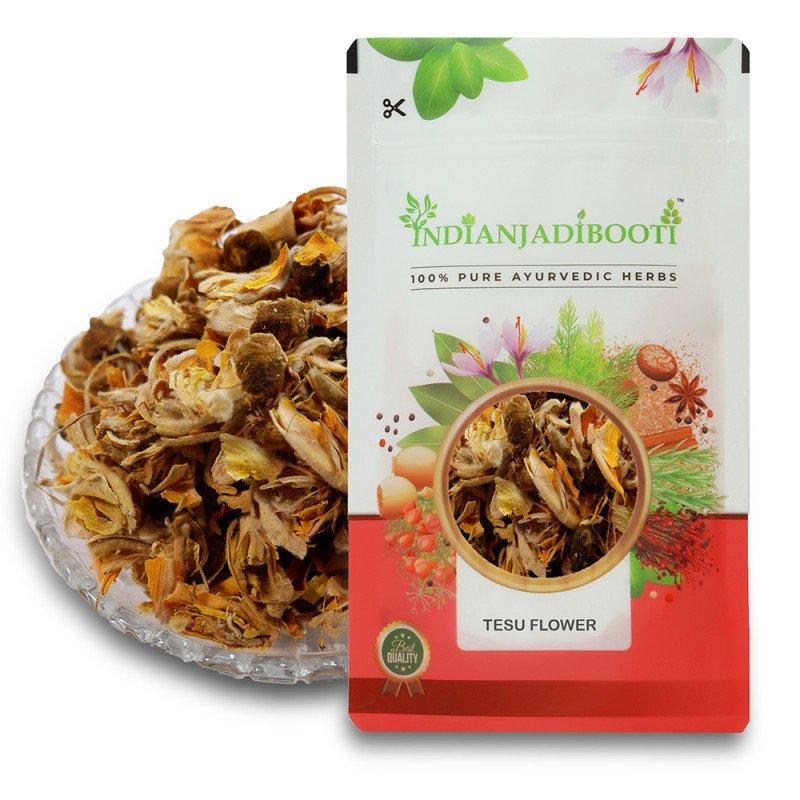
What is Tesu Flower (Butea Monosperma):
Tesu Flower (Butea Monosperma) also known as palash flower, Flame of the Forest or Flame of India, is a medium-sized tree native to India. It grows 20-40 feet high and has a crooked trunk, irregular branches, and grey bark. Its leaves are pinnate—each leaflet has an 8-16 cm petiole and three leaflets, each 10-20 cm long. The hindi phrase ढाक के तीन पात ("Dhaak ke teen paat") comes from the prominent three leaflets of this tree.
Also read: BENEFITS OF PALASH FLOWER
Flame of the Forest flowers in January and February. From December to March it looks ugly: most of the leaves fall off, leaving only bare branches. But during those months it truly becomes a tree of flame, with orange and vermilion flowers covering its crown. These flowers are scentless but massed along the ends of their stalks—dark velvety green like the cup-shaped calices—and their brilliance is shown off by this deep contrasting color. Each flower consists of five petals comprising one standard (large), two smaller wings (smaller than large), and a very curved beak-shaped keel (keel).
Other Names: Palas, Dhak, Palas, Tesu for holi color, palaash, Bastard Teak, Bengal Kino, Palas , Khakharo, Kakracha, Mooduga, palasamu, Parasa, Muttuga, Brahmavriksham, kimshukam, Chichra, dhak, palas, Palasha, Dhak, Palaash for Holi Colour, kesudo flower, polash, Butea Monosperma, Plaas
Uses:
The palash flower has long been associated with the festival of Holi, but it's not only this vibrant flower that's best known for its use on that day.
In fact, palash has a number of uses, both for medicinal and culinary purposes. The flowers are soaked in water to produce a colour that has traditionally been used to celebrate this festival. The flowers, along with other parts of the tree (like the bark and seeds), have also been appreciated for their medicinal uses for centuries. But like a number of other flowers, such as banana, moringa, rose and marigold—not to mention other indigenous ingredients like saunf and khas—palash has also been put to culinary use in India. Most frequently it's used to prepare cooling drinks.
But recently we've seen chefs, mixologists and other food professionals putting palash to good use! The flower has a very mild floral taste with an earthy bitter undertone. Because of this it goes well with other ingredients such as saunf or mint.
6 Comment(s)
Hello. Thank you!
This is the first time I have heard this flower - flame of the forest. A powerful and beautiful name.
The watch will be made in green, red, and blue, in a quantity of 100 examples each. The quantity isn’t entirely arbitrary: it’s a nod to Smith’s 39 victories in singles and 61 victories in doubles, totaling 100 wins. Stan is a champ, after all.
Playamo casino is one of the most popular online gaming platforms, offering a premium experience to players worldwide. It combines a sleek design, user-friendly interface, and a massive collection of games to create the perfect destination for entertainment and excitement. With thousands of titles from top software developers like NetEnt, Microgaming, and Pragmatic Play, players can enjoy everything from colorful slots and video poker to live dealer tables with real-time interaction.
One of the standout features of Playamo casino is its focus on secure and fast transactions. The platform supports multiple payment methods, including cryptocurrencies such as Bitcoin and Ethereum, ensuring both flexibility and safety. Withdrawals are processed quickly, often within hours, giving players instant access to their winnings.
Bonuses and promotions play a big role in enhancing the experience. New players receive generous welcome offers, while loyal members benefit from regular rewards, tournaments, and VIP perks. The casino is also fully optimized for mobile devices, allowing users to play smoothly on smartphones and tablets without losing quality.
With 24/7 customer support, fair gameplay, and an impressive reputation for reliability, Playamo casino remains a top choice for anyone seeking a secure, exciting, and rewarding online gambling experience.
I watched the finest brands in Switzerland crumble during the Quartz Crisis. Facing the challenge over a number of years, many rose like a phoenix. To see the energy in watchmaking today excites me. The styles that are popular now, I was showing clients in the late 1960s and 70s. It is refreshing to see how technology enhances the mechanical aspect of the watch while retaining the original design or brand essence.
In relatively short order, Zelos has become home to one of the most vibrant and interesting catalogs in the entire watch industry, stocking everything from a $350 dive watch to a $10,000 Swiss-made tourbillon. And somehow it all feels authentic to the brand identity Tang has built.
Leave a Comment